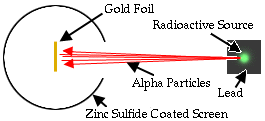

 |
 |
|
How Do We Experiment with Tiny Particles? Fixed-Target Experiments

In a fixed-target experiment, a charged particle such as an electron or a proton is accelerated by an electric field and collides with a target, which can be a solid, liquid, or gas. A detector determines the charge, momentum, mass, etc. of the resulting particles. An example of this process is Rutherford's gold foil experiment, in which the radioactive source provided high-energy alpha particles, which collided with the fixed target of the gold foil. The detector was the zinc sulfide screen.

|